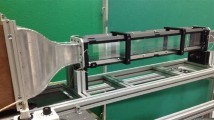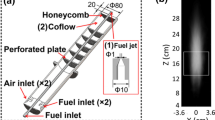Abstract
A new experimental method is described that provides high-speed movies of turbulent premixed flame wrinkling dynamics and the associated vorticity fields. This method employs cinema stereoscopic particle image velocimetry and has been applied to a turbulent slot Bunsen flame. Three-component velocity fields were measured with high temporal and spatial resolutions of 0.9 ms and 140 μm, respectively. The flame-front location was determined using a new multi-step method based on particle image gradients, which is described. Comparisons are made between flame fronts found with this method and simultaneous CH-PLIF images. These show that the flame contour determined corresponds well to the true location of maximum gas density gradient. Time histories of typical eddy–flame interactions are reported and several important phenomena identified. Outwardly rotating eddy pairs wrinkle the flame and are attenuated at they pass through the flamelet. Significant flame-generated vorticity is produced downstream of the wrinkled tip. Similar wrinkles are caused by larger groups of outwardly rotating eddies. Inwardly rotating pairs cause significant convex wrinkles that grow as the flame propagates. These wrinkles encounter other eddies that alter their behavior. The effects of the hydrodynamic and diffusive instabilities are observed and found to be significant contributors to the formation and propagation of wrinkles.












Similar content being viewed by others
References
Bell JB, Day MS, Grcar JF, Lijewski MJ, Driscoll JF, Filatev SA (2007) Numerical simulation of a laboratory-scale turbulent slot flame. Proc Combust Inst 31:1299–1307
Cabot G, Vauchelles D, Taupin B, Boukhalfa A (2004) Experimental study of lean premixed turbulent combustion in a scale gas turbine chamber. Exp Therm Fluid Sci 28(7):683–690
Chakraborty N, Cant RS (2005) Effects of strain rate and curvature on surface density function transport in turbulent premixed flames in the thin reaction zones regime. Phys Fluids 17(6)
Charlette F, Meneveau C, Veynante D (2002) A power-law flame wrinkling model for LES of premixed turbulent combustion. Part 1: non-dynamic formulation and initial tests. Combust Flame 131(2):159–180
Chen JH, Im HG (2000) Stretch effects on the burning velocity of turbulent premixed hydrogen/air flames. Proc Combust Inst 28:211–218
Cho Y, Kin JH, Cho T, Moon I, Yoon Y, Lee C (2004) Analysis of turbulent premixed flame structure using simultaneous PIV-OH PLIF. J Vis 7(1):43–54
Colin O, Ducros F, Veynante D, Poinsot T (2000) A thickened flame model for large eddy simulations of turbulent premixed combustion. Phys Fluids 12(7):1843–1863
Damköhler G (1940) Der einfluβ der turbulenz auf die flammengeschwindigkeit. Z Elektrochem 46:601–652
Denet B, Haldenwang P (1992) Numerical study of thermal-diffusive instability of premixed flames. Combust Sci Technol 86:199–221
Filatyev SA, Driscoll JF, Carter CD, Donbar JM (2005) Measured properties of turbulent premixed flames for model assessment, including burning velocities, stretch rates and surface densities. Combust Flame 141(1):1–21
Filatyev SA, Thariyan MP, Lucht RP, Gore JP (2007) Simultaneous stereo particle image velocimetry and double-pulsed planar laser-induced fluorescence of turbulent premixed flames. Combust Flame 150(3):201–209
Ganapathisubramani B, Lakshminarasimhan K, Clemens NT (2007) Determination of complete velocity gradient tensor by using cinematographic stereoscopic PIV in a turbulent jet. Exp Fluids 42(6):923–939
Hargrave GK, Jarvis S (2006) A study of premixed propagating flame vortex interaction. J Vis 9(2):179–187
Hawkes ER, Cant RS (2000) A flame surface density approach to large eddy simulation of premixed turbulent combustion. Proc Combust Inst 28:51–58
Hayashi S, Yamada H, Makida M (2005) Extending low-NOx operating range of a lean premixed-prevaporized gas turbine combustor by reaction of secondary mixtures injected into primary stage burned gas. Proc Combust Inst 30:2903–2911
Johnson MR, Littlejohn D, Nazeer WA, Smith KO, Cheng RK (2005) A comparison of the flowfields and emissions of high-swirl injectors and low-swirl injectors for lean premixed gas turbines. Proc Combust Inst 30:2867–2874
Kadowaki S (1999) The influence of hydrodynamic instability on the structure of cellular flames. Phys Fluids 11(11):3426–3433
Kobayashi H, Kawazoe K (2000) Flame instability effects on the smallest wrinkling scale and burning velocity of high-pressure turbulent premixed flames. Proc Combust Inst 28:375–382
Lee TW, North FL, Santavicca DA (1993) Surface properties of turbulent premixed propane/air flames at various Lewis numbers. Combust Flame 93(4):445–456
Lee JG, Lee TW, Santavicca DA (1995) Lewis number effects on premixed flames interacting with turbulent Karman vortex streets. Combust Flame 100(1):161–168
Louch DS, Bray KNC (2001) Vorticity in unsteady premixed flames: vortex pair–premixed flame interactions under imposed body forces and various degrees of heat release and laminar flame thickness. Combust Flame 125(4):1279–1309
Meneveau C, Poinsot T (1991) Stretching and quenching of flamelets in premixed turbulent combustion. Combust Flame 86(4):311–332
Mueller CJ, Driscoll JF, Reuss DL, Drake MC, Rosalik ME (1998) Vorticity generation and attenuation as vorticies convect through a flame. Combust Flame 112(3):342–358
Nye DA, Lee JG, Lee TW, Santavicca DA (1996) Flame stretch measurements during the interaction of premixed flames and turbulent Karman vortex streets using PIV. Combust Flame 105(1):167–179
Pan KL, Qian J, Law CK, Shyy W (2002) The role of hydrodynamic instability in flame–vortex interaction. Proc Combust Inst 29:1695–1704
Peters N (2000) Turbulent combustion. Cambridge University Press, Cambridge
Pfadler S, Löffler M, Dinkelacker F, Leipertz A (2005) Measurement of the conditioned turbulence and temperature field of a premixed Bunsen burner by planar laser Rayleigh scattering and stereo particle image volocimetry. Exp Fluids 39(2):375–384
Raffel M, Willert C, Kompenhans J (1998) Particle image velocimetry: a practical guide. Springer, Berlin
Renard PH, Rolon JC, Thevenin D, Candel S (1998) Wrinkling, poket formation and double premixed flame interaction processes. Proc Combust Inst 27:659–666
Roberts WL, Driscoll JF (1991) A laminar vortex interacting with a premixed flame: measured formation of pockets of reactants. Combust Flame 87(3):245–256
Sinibaldi JO, Mueller CJ, Tulkki AE, Driscoll JF (1998) Suppression of flame wrinkling by buoyancy: the baroclinic stabilization mechanism. AIAA J 36(8):1432–1438
Sivashinsky GI (1977) Non-linear analysis of hydrodynamic instability in laminar flames. 1 - Derivation of basic equations. Acta Astronaut 4:1177–1206
Stella A, Guj G, Kompenhans J, Richard H, Raffel M (2001) Three-components particle image velocimetry measurements in premixed flames. Aerosp Sci Technol 5:357–364
Sung CJ, Law CK, Axelbaum R (1994) Thermophoretic effects on seeding particles in LDV measurements of flames. Combust Sci Technol 99:199–132
Tanahashi M, Murakami S, Choi G, Fukuchi Y, Miyauchi T (2005) Simultaneous CH-OH PLIF and stereoscopic PIV measurements of turbulent premixed flames. Proc Combust Inst 30:1665–1672
Upatnieks A, Driscoll JF, Ceccio SL, Rasmussen CC (2004) Liftoff of turbulent jet flames—assessment of edge flame and other concepts using cinema-PIV. Combust Flame 138(3):259–272
Williams F (1985) Combustion theory, 2nd edn. Addison-Wesley, Reading
Yuan J, Ji Y, Law CK (2006) Effects of turbulence and flame instability of flame front evolution. Phys Fluids 18(10)
Author information
Authors and Affiliations
Corresponding author
Rights and permissions
About this article
Cite this article
Steinberg, A.M., Driscoll, J.F. & Ceccio, S.L. Measurements of turbulent premixed flame dynamics using cinema stereoscopic PIV. Exp Fluids 44, 985–999 (2008). https://doi.org/10.1007/s00348-007-0458-0
Received:
Revised:
Accepted:
Published:
Issue Date:
DOI: https://doi.org/10.1007/s00348-007-0458-0




